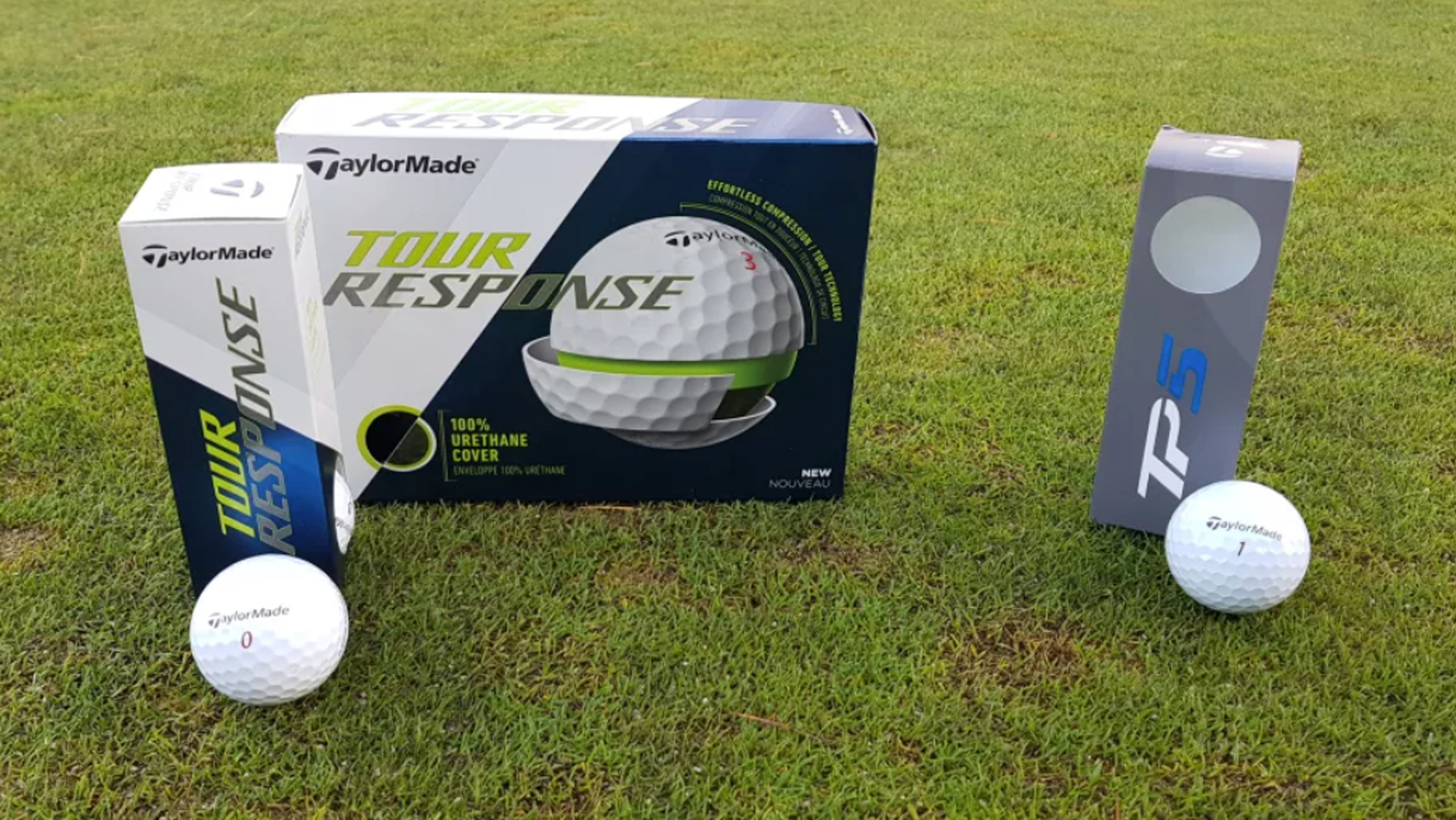TaylorMade Tour Response vs TaylorMade TP5
Tested: TaylorMade Tour Response vs TP5


TaylorMade Tour Response vs TaylorMade TP5
In this review of the TaylorMade Tour Response golf ball and the TaylorMade TP5, we compare two golf balls TaylorMade markets as offering tour standard performance.
This is an interesting match-up because TaylorMade created the great-value Tour Response ball in a bid to prise away golfers from buying the most expensive premium balls commonly used on professional tours, like the TP5.
The TP5 and TP5 X have been a revelation in professional golf since launching in 2017 and have been played by the biggest names in the game across TaylorMade’s equipment staff roster. This profile has helped TaylorMade win a significant share of the consumer golf ball market, mainly on the back of introducing the first-ever five-layer tour ball.
The Tour Response is designed to be an affordable alternative that appeals to a wider cross section of golfers. It’s a three-piece ball with a 100% urethane cover – the gold standard material for tour level golf balls – and is designed to offer equivalent performance to the best golf balls.
We tested both balls on the golf course and on a launch monitor to see how they compared.
Looks
Unbox these balls and first glance you might struggle to tell them apart. Both have 322 dimples, both have a premium urethane cover and both have a neat alignment arrow – split by the ball name - that is useful for lining up tee-shots and putts.
Tour Response has a deep red number while numbers on the TP5 are black. A closer look reveals that the difference is in the dimples. The 2021 TP5 ball has been reengineered with a seamless Tour Flight Dimple that is larger, wider and designed to improve the ball aerodynamics and extend its carry through the air.
Subscribe to the Golf Monthly newsletter to stay up to date with all the latest tour news, equipment news, reviews, head-to-heads and buyer’s guides from our team of experienced experts.

Feel
TaylorMade Tour Response is a low compression ball, measured around 70 compression, so you’d expect it to fell softer compared to the TP5 which is an 85 compression ball.
It was difficult to tell which had the softer feel in testing. Both are excellent on well struck shots but on off centre contact the Tour Response feels firm, solid, even a touch dull.
The TP5 does feel firm for a premium tour ball which could be explained by its five-piece construction. It has a soft cast urethane cover and a firm inner cover protecting a larger more reactive core. In between, you have TaylorMade’s Speed Layer system of increasingly stiffer layers, so what you get is more ball speed and a spring like effect off the face.
The Tour Response also feels firm but springy. There’s an obvious energy transfer as the ball zips off the face. TaylorMade call this its ‘hi-spring core’ and they’ve coupled it with a thinner HMFq SPEEDMANTLE™ for advanced ball speed. As good as it is, the 5-layer ball simply feels better and more explosive than its 3-piece rival.
Ball Flight
In long game testing, the TaylorMade Tour Response gave a good showing vs TP5 but simply couldn’t match the performance of the more expensive ball in windy conditions.
The TaylorMade TP5 seems to fly like a piece of rope in the wind on good shots. It holds it line so well and noticeably better than other tour balls I’ve tested and played.
On the course, both balls launched well and reached a healthy peak height that meant shots held the greens well.
With shorter irons, I found the TP5 launched lower and span more, a great combination for attacking flags with wedge. Tour Response was also low-mid launch on pitches and wedge shots and impressive in its own right, with plenty of hop and stop check.
On mid to long iron shots, both balls had the stable flight you expect from the best TaylorMade golf balls but TP5 had a better peak height on launch monitor testing, was longer and had a better angle of descent – meaning it stops quicker and will spin more when it hits the green.
The Tour Response is a good all-rounder and performed well on the course on a breezy day but launch monitor testing revealed it fell short of TP5 performance in terms of distance and spin rates.

TaylorMade Tour Response
Distance
In a comparative test of 10 seven-iron shots, the spin rate on the Tour Response often hit 7500 rpm plus whereas the TP5 span less, averaging around 6850 rpm of backspin. This tallied with TaylorMade’s new Tour Flight Dimple technology, which aims to launch it higher, spin it less and carry it further. Well struck shots with TP5 were consistently longer than with Tour Response but the cheaper ball was no slouch.
Ball speed was consistently between 117 and 120mph and the shots were grouped in a range of 170 to 176 yards for Tour Response.
On the course, my driver had good launch and a lower spinning, flatter flight with the TP5 which cut through the wind. The Tour Response launched higher, flew higher and span more – the result being that the drives I hit with the TP5 were often 5 to 10 yards longer.
Control
Good control of ball flight is one of the stand out benefits of these TaylorMade tour quality golf balls. Stability of flight, from driver to wedge, is the defining characteristic for both models – with TP5 the stronger option of the two.
Compared to the best premium golf balls both the TaylorMade Tour Response and the TP5 feel firm on contact but they are soft enough for any standard of player and make up for firmness with high wedge spin, hop-and-stop control and good explosive feel on long and mid-iron shots.
I found the TP5 offered more short game control but it wasn’t easy to tell them apart when putting, both are firm off the face but roll well and held the green surface nicely.
The TP5 offered more control with driver thanks to its lower spinning flatter flight, ideal for playing in the wind and getting valuable run out on drier fairways in the Summer months.
Which ball should you choose?
Choose the TaylorMade Tour Response if...
- You want a cheaper alternative to premium tour balls
- You want higher launch, consistent distance and stable flight in the long game
- You prefer a firmer feel green side
Choose the TP5 if…
- You want to hit more penetrating drives
- Like to attack flags with low flighted pitches that hop-and-stop
- You play in windy conditions and need enhanced flight control
If you choose to buy, check out our helpful TaylorMade discount codes.
Matthew Moore fell in love with golf hitting an old 3-iron around his school playing field imagining rugby posts were flags and long jump pits as bunkers.
He earned golf scholarships to the University of St Andrews and Emory University, Atlanta, U.S.A and dreamed of playing professionally before training as a journalist.
He has worked at Golf Monthly and CNN Sports as well as covering golf news, features, products and travel as a freelance writer and TV presenter for newspapers, magazines and corporate clients. Matthew has interviewed Ryder Cup Captains, Major Champions and legends of the game and rates sharing a glass of rioja and a bowl of nuts with Miguel Angel Jimenez as his favourite moment. Matthew plays off 1, has won five club championships and aced the first hole of Augusta National’s Par-3 course in 2002.


